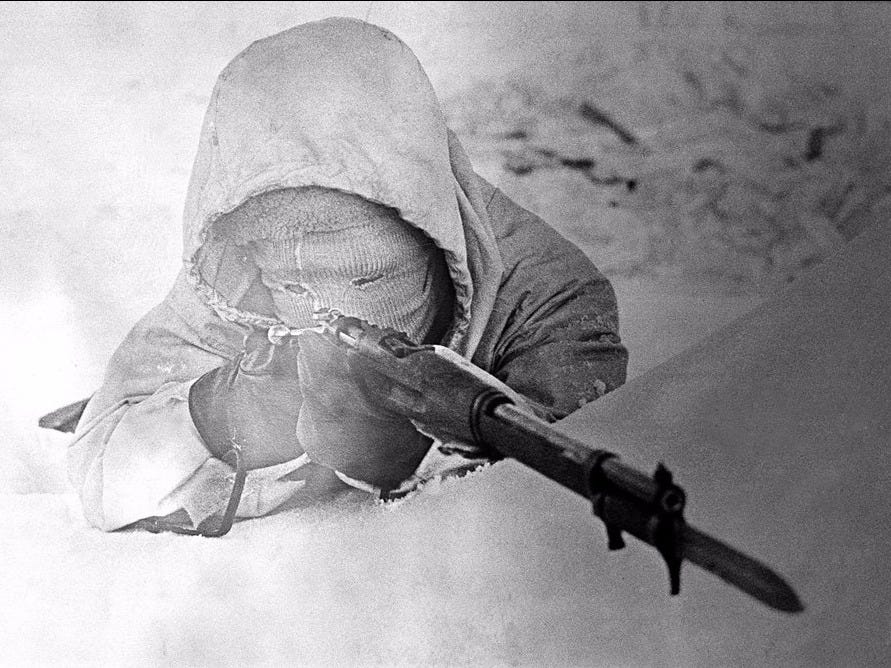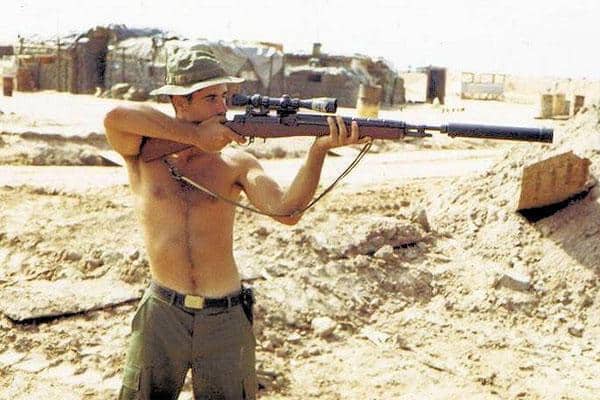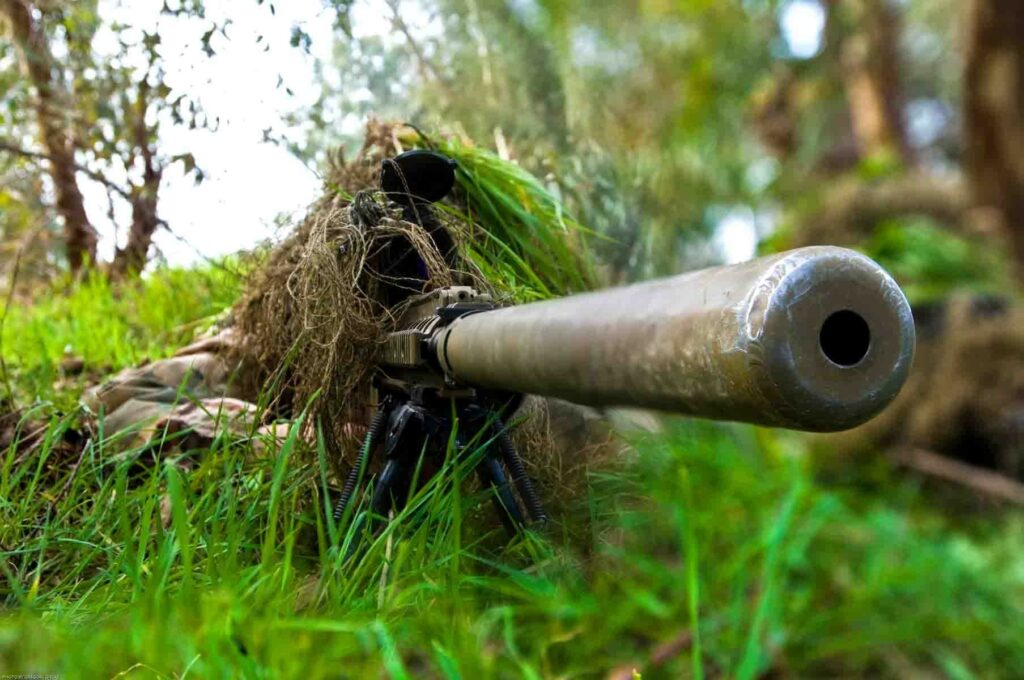Snipers utilize a craft all their own. It’s an odd one that involves small elite teams, armed with accurate rifles, often going out alone and away from the cover an army provides. Snipers are known for their kills and ability to hit precise targets at long ranges, but they do much more than that. Snipers change the battlefield, demoralize the enemy, act as scouts, conducting reconnaissance and often provide precision fire right where it’s needed most as operations progress.
We’ve gathered a list of the deadliest snipers that changed the face of warfare as we know it. They not only hunted their enemy with dangerous precision, but pushed the tactics and technology of their given trade forward as well.
Simo Häyhä

Simo Häyhä is proof you can do more with less. Armed with an iron-sighted M/28-30 and a submachine gun, he wreaked havoc on the Russians during the Winter War (sometimes known as First Soviet-Finnish War). Simo Häyhä did more than shoot well. He could track, navigate, and camouflage himself into his environment with ease.
Simo Häyhä earned his nickname the “White Death” due to the white camouflage he wore as he snuck through the snow, taking shots at Russian soldiers as he went.
His personal journal stated he killed around 500 men, and those reports were backed by official records when both his rifle and submachine gun were taken into consideration.
For 100 straight days, he decimated Russian forces and was only stopped by an explosive bullet to the face. Of course, it would take more than that to stop the White Death. He recovered from his injuries and would live on to the ripe old age of 96.
Lyudmila Pavlichenko

Born the unassuming daughter of a locksmith, Lyudmila Pavlichenko joined a shooting club at age 14, where she quickly earned her sharpshooter badge and a marksmanship certificate. A decade later, when the Nazis began their invasion of the Soviet Union, she was one of the first at the Army recruiter’s door. She quickly distinguished herself as a fearsome sniper while serving in one of the most fearsome environments known to man.
Pavlichenko fought in both the siege of Odesa and the siege of Sevastopol. She racked up kill after kill against Nazi forces, eventually coming to be known by her peers and opponents alike as “Lady Death.”
All told, Lady Death killed 309 Nazis during her reign, and was reportedly always ready for a fight. In the dense urban terrain of both sieges, she had to be creative to mask her shots, to camouflage herself, and to remain victorious when outnumbered and outgunned.
It took a mortar to stop Lyudmila Pavlichenko, but she even eventually shrugged that off. She recovered in a hospital for a month and then went back to work training more snipers for the war. Pavlichenko survived the war and lived until the age of 58, when she suffered a stroke and passed away shortly thereafter.
Vasily Zaitsev

Another Soviet sniper answered his country’s call of duty with a Mosin Nagant and a pack full of harmful intentions aimed at the Nazis. Like many snipers of his day, his skills came from being a hunter. Specifically, Vasily Zaitsev hunted wolves. While hunting men during the war, he pioneered a tactic used in urban sniping sometimes called, “hide and sting.” The tactic called on the sniper to adopt a concealed position, take a few targets down with well aimed shots, then boot, scoot and boogie to a new location.
Zaitsev was known to hide among the rubble, in water pipes, and anywhere else that might conceal his presence from the enemy. This allowed him to sit and wait while hunting Nazis, much like he would sit and wait to hunt wolves as a boy. He devastated the German army in Stalingrad, killing over 225 Germans.
While he accomplished much as a sniper, his biggest contribution was in the realm of sniper tactics. Obviously, he used them to great success, but those same tactics were adopted by various Soviet snipers and increased their effectiveness as well. Zaitsev took a mortar blast to the face, but like the previous two snipers we’ve discussed, he too survived and lived on to the age of 76.
Carlos Hathcock

U.S. Marine Sniper Carlos Hathcock might be the most famous sniper in American culture. He fought in Vietnam, where he earned the name “White Feather” for the feather he reportedly kept in his bush hat. Hathcock was already a distinguished shooter before he became an incredibly efficient sniper.
In Vietnam, he killed over 90 men with a variety of firearms. While his kill records prove impressive, he was not the most successful sniper in American history if you just look at the numbers. Hathcock’s fame and reputation come from more than just his kills, however.
His tenacity allowed him to complete incredibly dangerous missions alone and often without support. In one instance, he killed a high-value target after a brutal two-day stalk where he moved only inches at a time and was often within just feet of enemy patrols.
Hathcock also stalked enemy sharpshooters throughout the war, eliminating famed Vietnamese snipers known as Cobra and the Apache Woman. For many decades, he held the record for the longest-distance confirmed kill, which he got by using an M2 .50 caliber machine gun. He was one of many snipers who used the M2 as a sniping weapon, and this later contributed to the adoption of a 50 BMG sniper rifle.
Chuck Mawhinney

Chuck Mawhinney holds the record for the most sniper kills in the Marine Corps, all earned during the Vietnam war. He served 16 months overseas and killed 103 enemy soldiers, with 216 more probable kills. At one point, he was caught by a platoon of enemy soldiers. He killed 16 of them with headshots before escaping.
In Vietnam, he was sent to work with several units, including Force Recon, CAG, and numerous Marine companies. Mawhinney acted as a gun for hire of sorts, who drifted from town to town and unit to unit; a very ‘have gun, will travel,’ type. His skills and ability to kill were unmatched, so he was frequently sought after for difficult missions.
Chuck remained modest and never sought glory for his actions. Heck, his wife didn’t even know he was a sniper. After the war, he worked in the Forest Service until he retired, and it wasn’t until later in his life that his heroic feats in battle were discovered by the people around him. Chuck is still alive today, and has worked with the History Channel and Strider knives, among others. You can see his rifle at the National Museum of the Marine Corps.
Adelbert Waldron

The US Army’s Adelbert Waldron was the most successful sniper in Vietnam, with 109 confirmed kills. Despite his legendary prowess, most people don’t know his name. Prior to being a soldier, he served for 12 years in the U.S. Navy as a Sailor. In the army, he was logically assigned to boats patrolling the Mekong Delta.
During this time, he reportedly landed a shot at 900 yards from a moving boat.
Imagine the water rocking and rolling as you tried to align your sights on a target that far away. Adelbert Waldron, however, wasn’t done, and continued to prove himself as one of the most brutal snipers of the conflict.
It was said that in the darkness of the Mekong Delta, you belonged to Bert and his rifle. That rifle being the XM21 sniper rifle. This improved and optically enhanced M14 allowed Bert to pick off enemy forces at a multitude of ranges with ease. He earned two Distinguished Service Crosses, a Silver Star, and numerous Bronze Stars before hanging up his uniform. He left the army after Vietnam and lived to the age of 62.
Nicholas Irving

Nicholas Irving, also known as the Reaper, served in the 3rd Ranger Battalion as a sniper in both Iraq and Afghanistan. There, he became an unstoppable force in combat wielding an SR-25 sniper rifle that he nicknamed Dirty Diana. He and Dirty Diana set a record for 33 kills in just three-and-a-half months.
Sergeant Irving completed six deployments, and in that time, he served as an assaulter, machine gunner, and of course, a sniper.
His wide breadth of experience gave him an edge in the new type of warfare that would come to define the War on Terror. This new conflict moved fast, and snipers had to adapt or get left behind. Irving adapted quickly, proving that any battlefield could be a sniper’s hide.
The use of semi-auto rifles for snipers was rare early in the GWOT, and the success of Irving and his team of snipers helped propel the concept forward. These days, the most common rifle for sniping is a variant of the SR-25. Irving left his mark on sniper culture and currently works on a number of projects. In 2014, he wrote an autobiography that’s worth reading for any GWOT historian.
Chris Kyle

Chris Kyle might be one of the most famous and controversial figures to arise from the Global War on Terror. Regardless of the controversy, no one argues that the man was an extremely successful sniper. He served as a Navy SEAL in Iraq and took part in the initial invasion in 2003.
There he worked his craft with a variety of rifles, often preferring the heavier and more powerful 338 Lapuas and 300 Win Mag rifles that were becoming popular with the teams at the time.
According to the Navy, he has over 150 confirmed kills, although they’ve never released the official figure.
Chris Kyle became a legend in Iraq and worked to protect hundreds of Marines during battles in dense urban environments. He often credits his success with luck and being in the right place at the right time. However, as valuable as luck is, skill and training are why he was successful. He survived two gunshot wounds and six IED explosions and seemed practically invincible in country. Sadly after his service, his life was cut short when he was murdered by a troubled Marine veteran.
Snipers Throughout History
Snipers have long been force multipliers for the progressive commander who knows the value of a skilled shooter. Throughout history, they’ve proven themselves to be extremely effective at not only killing the enemy, but demoralizing them. While kills are one way to measure a sniper’s success, there is value in the techniques, skills, and tactics they bring to their craft. These men and women are testaments to what snipers are capable of in both of those important regards.




